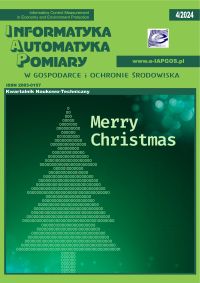MIERNIK CYFROWY DO POMIARÓW KONTAKTOWEJ RÓŻNICY POTENCJAŁÓW PRZEZNACZONY DO KONTROLI DEFORMACJI MATERIAŁÓW DIELEKTRYCZNYCH
Kanstantsin Pantsialeyeu
k.pantsialeyeu@bntu.byBelarusian National Technical University, Instrumentation Engineering Faculty (Białoruś)
http://orcid.org/0000-0001-7113-1815
Anatoly Zharin
Belarusian National Technical University, Instrumentation Engineering Faculty (Białoruś)
http://orcid.org/0000-0001-7213-4532
Oleg Gusev
Belarusian National Technical University, Instrumentation Engineering Faculty (Białoruś)
http://orcid.org/0000-0001-5180-1121
Roman Vorobey
Belarusian National Technical University, Instrumentation Engineering Faculty (Białoruś)
http://orcid.org/0000-0003-2851-6108
Andrey Tyavlovsky
Belarusian National Technical University, Instrumentation Engineering Faculty (Białoruś)
http://orcid.org/0000-0003-2579-1016
Konstantin Tyavlovsky
Belarusian National Technical University, Instrumentation Engineering Faculty (Białoruś)
http://orcid.org/0000-0001-8020-0165
Aliaksandr Svistun
Belarusian National Technical University, Instrumentation Engineering Faculty (Białoruś)
http://orcid.org/0000-0002-9593-8880
Abstrakt
W artykule przedstawiono wyniki badań rozkładu wymuszonych ładunków na powierzchni dielektryków metodą kontaktowej różnicy potencjałów (angl. CPD). Wcześniej metoda CPD była stosowana jedynie do badań powierzchni metali lub półprzewodników. Trudności stosowania metody CPD w stosunku do dielektryków wynikają z konieczności całkowitej kompensacji potencjału powierzchniowego, wartość którego może być wysoka. W praktyce taka kompensacja może być utrudniona. W związku z tym metoda CPD nie jest stosowana do badań dielektryków. Ostatnio do techniki pomiarów metodą CPD wprowadzono szereg udoskonaleń, które wyeliminowały konieczność całkowitej kompensacji mierzonych wartości. Nowa metoda, która nie wymaga kompensacji, została zrealizowana w postaci cyfrowej sondy Kelvina. W artykule przeanalizowano zasady działania sondy nie wymagającej kompensacji oraz jej zastosowanie do określenia rozkładu ładunku na powierzchni dielektryków w szerokim zakresie wartości potencjału. Badania przeprowadzono na materiałach polimerowych, takich jak polietylen o małej gęstości (LDPE) i politetrafluoroetylen (PTFE).
Słowa kluczowe:
rozkład ładunku powierzchniowego, kontaktowa różnica potencjałów, skanująca sonda Kelvina, materiały dielektryczneBibliografia
Baumgartner H.: New method for the distance control of a scanning Kelvin microscope. Measurement science & technology 2(3), 1992, 237–238.
DOI: https://doi.org/10.1088/0957-0233/3/2/017
Google Scholar
Brain K. R.: Investigations of piezo-electric effects with dielectrics. Proceedings of the Physical Society of London 36(1), 1923.
DOI: https://doi.org/10.1088/1478-7814/36/1/309
Google Scholar
Broadhurst M. G., Malmberg C. G., Mopsik F. I., Harris W. P.: Piezo- and pyro-electricity in polymer electrets. Conference on Electrical Insulation & Dielectric Phenomena. Annual Report, 1972 [http://doi.org/10.1109/ceidp.1972.7734193].
DOI: https://doi.org/10.1109/CEIDP.1972.7734193
Google Scholar
Davies D. K.: Charge generation on dielectric surfaces. Journal of Physics D: Applied Physics 2(11), 1969, 1533–1537 [http://doi.org/10.1088/0022-3727/2/11/307].
DOI: https://doi.org/10.1088/0022-3727/2/11/307
Google Scholar
Dogadkin B. A., Gul V. E., Morozova N. A.: The Effect of Electric Charges Formed during Repeated Deformations on the Fatigue Resistance of Vulcanizates. Rubber Chemistry and Technology 33(4), 1960 [http://doi.org/10.5254/1.3542237].
DOI: https://doi.org/10.5254/1.3542237
Google Scholar
Kelvin L.: Contact electricity of metals. Philosophical Magazine (series 5) 46(278), 1898, 82–120 [http://doi.org/10.1080/14786449808621172].
DOI: https://doi.org/10.1080/14786449808621172
Google Scholar
Lei Zhang, Zhiwei Chen, Jiale Mao, Shuang Wang, Yiting Zheng: Quantitative evaluation of inclusion homogeneity in composites and the applications (Review Article). Journal of Materials Research and Technology 9(3), 2020 [http://doi.org/10.1016/j.jmrt.2020.01.067].
DOI: https://doi.org/10.1016/j.jmrt.2020.01.067
Google Scholar
Pantsialeyeu K. U., Krautsevich A. U., Rovba I. A., Lysenko V. I., Vorobey R. I., Gusev O. K., Zharin A. L.: Analysis of the electrophysical and photoelectric properties of nanocomposite polymers by the modified Kelvin probe. Devices and Methods of Measurements 8(4), 2017, 386–397 (in russian) [http://doi.org/10.21122/2220-9506-2017-8-4-55-62].
DOI: https://doi.org/10.21122/2220-9506-2017-8-4-55-62
Google Scholar
Pantsialeyeu K., Mikitsevich U., Zharin A.: Design of the contact potentials difference probes. Devices and Methods of Measurements 7(1), 2016, 7–15 (in russian) [http://doi.org/10.21122/2220-9506-2016-7-1-7-15].
DOI: https://doi.org/10.21122/2220-9506-2016-7-1-7-15
Google Scholar
Pantsialeyeu K., Svistun A., Tyavlovsky A., Zharin A.: Digital contact potential difference probe. Devices and Methods of Measurements 7(2), 2016, 136–144 (in russian) [http://doi.org/10.21122/2220-9506-2016-7-2-136-144].
DOI: https://doi.org/10.21122/2220-9506-2016-7-2-136-144
Google Scholar
Pantsialeyeu K., Svistun A., Zharin A.: Methods for local changes in the plastic deformation diagnostics on the work function. Devices and Methods of Measurements 10(1), 2015, 56–63.
Google Scholar
Pilipenko V., Solodukha V., Zharin A., Gusev O., Vorobey R., Pantsialeyeu K., Tyavlovsky A., Tyavlovsky K., Bondariev V.: Influence of rapid thermal treatment of initial silicon wafers on the electrophysical properties of silicon dioxide obtained by pyrogenous oxidation. High Temperature Material Processes: An International Quarterly of High-Technology Plasma Processes 23(3), 2019, 283–290 [http://doi.org/10.1615/HighTempMatProc.2019031122].
DOI: https://doi.org/10.1615/HighTempMatProc.2019031122
Google Scholar
Qin W. G., Shaw D. A.: Theoretical model on surface electronic behaviour: strain effect. Phys. B: Condensed Matter 6(16), 2009, 2247–2250.
Google Scholar
Sviridenok A., Zharin A., Krautsevich A., Tyavlovsky A.: The effect of high-dispersion fillers on adhesive and frictional properties of ethylene-vinyl acetate copolymer. Journal of Friction and Wear 35, 2014, 255–262.
DOI: https://doi.org/10.3103/S1068366614040114
Google Scholar
Sykes J. M., Doherty M.: Interpretation of Scanning Kelvin Probe potential maps for coated steel using semi-quantitative current density maps. Corrosion Science 50, 2008, 2773–2778 [http://doi.org/10.1016/j.corsci.2008.07.023].
DOI: https://doi.org/10.1016/j.corsci.2008.07.023
Google Scholar
Tyavlovsky A. K., Zharin A. L., Gusev O. K., Kierczynski K.: Kelvin Probe error compensation based on harmonic analysis of measurement signal. Przeglad Elektrotechniczny 90, 2014, 251–254.
Google Scholar
Vorobey R. I. Gusev O. K. Tyavlovsky A. K., Svistun A. I., Shadurskaja L., Yarzhembiyskaja N., Kerczynski K.: Controlling the characteristics of photovoltaic cell based on their own semiconductors. Przeglad Elektrotechniczny 91(8), 2015, 81–85 [http://doi.org/10.15199/48.2015.08.21].
DOI: https://doi.org/10.15199/48.2015.08.21
Google Scholar
Wicinski M., Burgstaller W., Hassel A. W.: Lateral resolution in scanning Kelvin probe microscopy. Corrosion Science 104, 2016, 1–8 [http://doi.org/10.1016/j.corsci.2015.09.008].
DOI: https://doi.org/10.1016/j.corsci.2015.09.008
Google Scholar
Zharin A., Pantsialeyeu K., Kierczyński K.: Charge sensitive techniques in control of the homogeneity of optical metallic surfaces. Przegląd Elektrotechniczny 92(8), 2016, 190–193
Google Scholar
[http://doi.org/10.15199/48.2016.08.52].
DOI: https://doi.org/10.15199/48.2016.08.52
Google Scholar
Zharin A., Pantsialeyeu K., Opielak M., Rogalski P.: Charge sensitive techniques in tribology studies. Przegląd Elektrotechniczny 92(11), 2016, 239–243 [http://doi.org/10.15199 / 48.2016.11.58].
DOI: https://doi.org/10.15199/48.2016.11.58
Google Scholar
Zisman W.: A new method of measuring contact potential differences in metals. Review of Scientific Instruments 3(7), 1932, 367–370 [http://doi.org/10.1063/1.1748947].
DOI: https://doi.org/10.1063/1.1748947
Google Scholar
Autorzy
Kanstantsin Pantsialeyeuk.pantsialeyeu@bntu.by
Belarusian National Technical University, Instrumentation Engineering Faculty Białoruś
http://orcid.org/0000-0001-7113-1815
Autorzy
Anatoly ZharinBelarusian National Technical University, Instrumentation Engineering Faculty Białoruś
http://orcid.org/0000-0001-7213-4532
Autorzy
Oleg GusevBelarusian National Technical University, Instrumentation Engineering Faculty Białoruś
http://orcid.org/0000-0001-5180-1121
Autorzy
Roman VorobeyBelarusian National Technical University, Instrumentation Engineering Faculty Białoruś
http://orcid.org/0000-0003-2851-6108
Autorzy
Andrey TyavlovskyBelarusian National Technical University, Instrumentation Engineering Faculty Białoruś
http://orcid.org/0000-0003-2579-1016
Autorzy
Konstantin TyavlovskyBelarusian National Technical University, Instrumentation Engineering Faculty Białoruś
http://orcid.org/0000-0001-8020-0165
Autorzy
Aliaksandr SvistunBelarusian National Technical University, Instrumentation Engineering Faculty Białoruś
http://orcid.org/0000-0002-9593-8880
Statystyki
Abstract views: 366PDF downloads: 173
Licencja

Utwór dostępny jest na licencji Creative Commons Uznanie autorstwa – Na tych samych warunkach 4.0 Miedzynarodowe.








